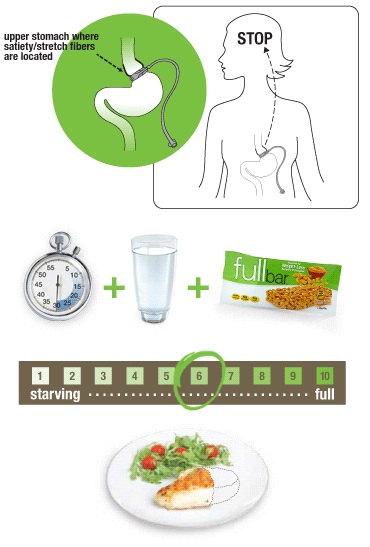The Fullbar: Surgery in a snack?
During one recent bout of the 3 p.m. munchies, I stopped at a nearby convenience store to grab a granola bar. I stood surveying my options for a good 10 minutes (Chewy? Crunchy? Organic? One with peanut butter?) before my eyes fell on the Fullbar.
Developed by bariatric surgeon Dr. Michael Snyder, the Fullbar is meant to aid weight loss using the same principles as gastric-bypass surgery. Eat it 30 minutes before a meal with a glass of water, and you’ll be too full to overindulge when you sit down at the table—just like a surgically shrunken stomach prevents you from consuming too much food.
I found this out only after the fact; I bought it because it was the biggest bar and promised to make me full. But after examining the label I had to check it out further. The ingredients—brown-rice syrup, puffed wheat, honey, soy protein—didn’t seem particularly unique to me. So how does an ordinary bar achieve such extraordinary results?
Answer: it doesn’t. Dr. Snyder’s website claims that “when you use Fullbar products, your stomach fills up on less food,” but it doesn’t explain how. He offers only that the snacks are “designed with highly filling combinations of premium fiber, protein and volume to fill more space in your stomach with fewer calories.” First of all, “volume” was not a food ingredient last time I checked. Second, the combination of fiber and protein (“premium” or otherwise) is widely known for its satiating properties and claimed by a host of other snacks that clock in at roughly the same nutrition stats as Snyder’s creation. A Cocoa Chip Fullbar contains 160 calories, five grams of fiber, and four grams of protein. Other worthy snacks include:
• A six-ounce serving of plain Greek yogurt with sliced banana: 200 cals, 3 g. fiber, 18 g. protein
• Luna Toasted Nuts ‘n Cranberry Bar: 170 cals, 3 g. fiber, 9 g. protein
• ½ cup of Kashi GoLean Crunch cereal with a ½ cup of skim milk: 140 cals, 4 g. of fiber, 9.5 g. protein
Contrary to what the advertising wants you to believe, the Fullbar doesn’t have any special properties that magically fill you up. It adheres to the most basic diet principle: Eat when you’re hungry, stop when you’re not. Eating a nutritious snack before dinner to quash the craving for a second scoop of mac ‘n cheese isn’t innovative—it’s common sense.
Dieters beware: Products making claims that seem too good to be true usually are. There’s no secret trick to make you lose weight and keep it off. Sure, the Fullbar may help you feel fuller before dinner, but it’s still up to you to govern that dinner. That means filling your plate with a small portion of lean protein, lots of veggies, and some healthy whole grains, and keeping it to one plate. Sticking to a well-rounded diet plan throughout the day is a better way to stave off hunger than buying into faux-scientific marketing ploys.
What do you think? Have you tried any weight-loss gimmicks that worked—or didn’t? Share your thoughts in the comments below!



